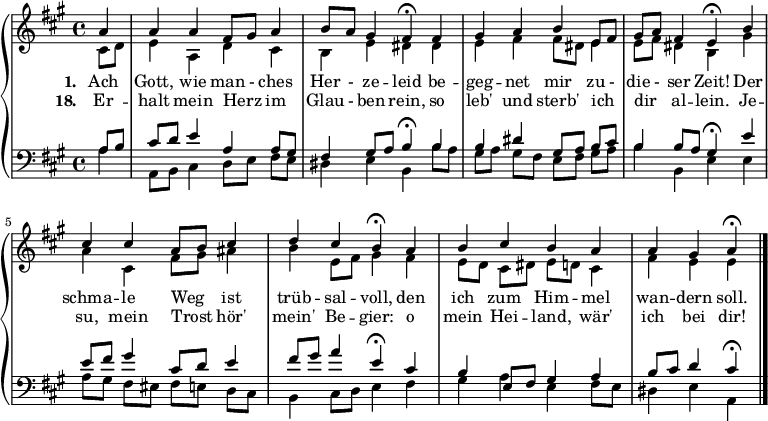
Ach Gott, wie manches Herzeleid, BWV 3, is a church cantata by Johann Sebastian Bach. He composed the chorale cantata in Leipzig for the Second Sunday after Epiphany and first performed it on 14 January 1725. It is based on the hymn published by Martin Moller in 1587.
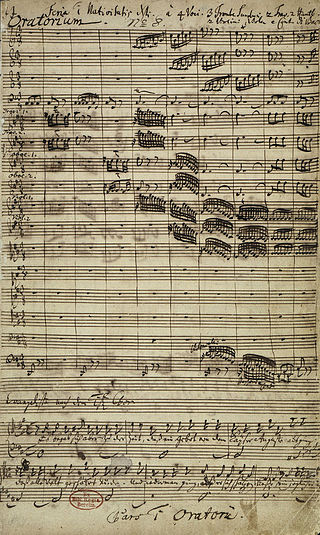
The Christmas Oratorio, BWV 248, is an oratorio by Johann Sebastian Bach intended for performance in church during the Christmas season. It is in six parts, each part a cantata intended for performance in a church service on a feast day of the Christmas period. It was written for the Christmas season of 1734 and incorporates music from earlier compositions, including three secular cantatas written during 1733 and 1734 and a largely lost church cantata, BWV 248a. The date is confirmed in Bach's autograph manuscript. The next complete public performance was not until 17 December 1857 by the Sing-Akademie zu Berlin under Eduard Grell. The Christmas Oratorio is a particularly sophisticated example of parody music. The author of the text is unknown, although a likely collaborator was Christian Friedrich Henrici (Picander).

Ach Gott, wie manches Herzeleid, BWV 58, is a church cantata by Johann Sebastian Bach. He composed the dialogue cantata in Leipzig for the Sunday after New Year's Day.

Sie werden euch in den Bann tun, BWV 44, is a church cantata by Johann Sebastian Bach. He composed it in Leipzig for Exaudi, the Sunday after Ascension, and first performed it on 21 May 1724.
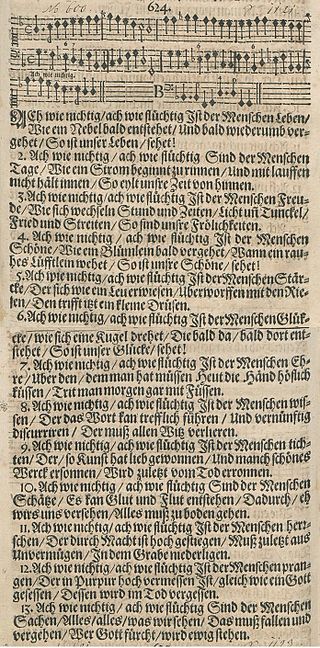
"Ach wie flüchtig, ach wie nichtig" is a German Lutheran hymn with lyrics by Michael Franck, who published it with his own melody and a four-part setting in 1652. Johann Crüger's reworked version of the hymn tune was published in 1661. Several Baroque composers used the hymn, including Johann Sebastian Bach, who wrote a chorale cantata. It is part of the current Protestant hymnal Evangelisches Gesangbuch, and has also been used by 20th-century composers such as Ernst Pepping and Mauricio Kagel.

"Gelobet seist du, Jesu Christ" is a Lutheran hymn, written by Martin Luther in 1524. It was first published in 1524 in the Eyn geystlich Gesangk Buchleyn. For centuries the chorale has been the prominent hymn (Hauptlied) for Christmas Day in German speaking Lutheranism, but has also been used in different translations internationally. It has appeared in hymnals of various denominations including the Catholic Church.

Schau, lieber Gott, wie meine Feind, BWV 153, is a church cantata by Johann Sebastian Bach. He composed it in Leipzig for the Sunday after New Year's Day and first performed it on 2 January 1724.
There are 52 chorale cantatas by Johann Sebastian Bach surviving in at least one complete version. Around 40 of these were composed during his second year as Thomaskantor in Leipzig, which started after Trinity Sunday 4 June 1724, and form the backbone of his chorale cantata cycle. The eldest known cantata by Bach, an early version of Christ lag in Todes Banden, BWV 4, presumably written in 1707, was a chorale cantata. The last chorale cantata he wrote in his second year in Leipzig was Wie schön leuchtet der Morgenstern, BWV 1, first performed on Palm Sunday, 25 March 1725. In the ten years after that he wrote at least a dozen further chorale cantatas and other cantatas that were added to his chorale cantata cycle.
O Jesu Christ, meins Lebens Licht, BWV 118, is a sacred motet composed by Johann Sebastian Bach. It is known to have been performed at a funeral, and was possibly a generic work intended for funerals. When the work was first published in the nineteenth century it was called a cantata, perhaps because it has an instrumental accompaniment. While it is not an a cappella work, modern scholarship accepts it is a motet.
"Herzlich lieb hab ich dich, o Herr" is a Lutheran hymn in German by the Protestant theologian and reformer Martin Schalling, written in Amberg in 1569 and first printed in 1571. It is sung to an anonymous melody, Zahn No. 8326, which appeared in a tablature book for organ in 1577. The hymn is often used for funerals, especially the third and last stanza, "Ach Herr, laß dein lieb Engelein". It appears in the current German Protestant hymnal Evangelisches Gesangbuch (EG).
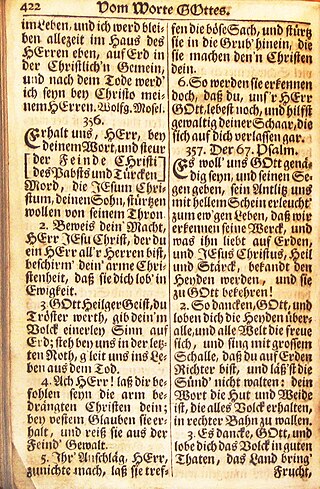
"Erhalt uns, Herr, bei deinem Wort" is a Lutheran hymn by Martin Luther with additional stanzas by Justus Jonas, first published in 1542. It was used in several musical settings, including the chorale cantata by Johann Sebastian Bach, Erhalt uns, Herr, bei deinem Wort, BWV 126.

Martin Behm (1557–1622) was a German hymnwriter.
Johann Sebastian Bach's chorale cantata cycle is the year-cycle of church cantatas he started composing in Leipzig from the first Sunday after Trinity in 1724. It followed the cantata cycle he had composed from his appointment as Thomaskantor after Trinity in 1723.
"Herr Jesu Christ, wahr Mensch und Gott" is a Lutheran hymn by Paul Eber. It is a hymn for the dying. One of the hymn's tunes, Zahn No. 423, is also used for "Wir danken dir, Herr Jesu Christ".
"Werde munter, mein Gemüte" is a Lutheran evening hymn by Johann Rist in twelve stanzas of eight lines each, printed in 1642. The hymn was translated to English and appeared in 67 hymnals.
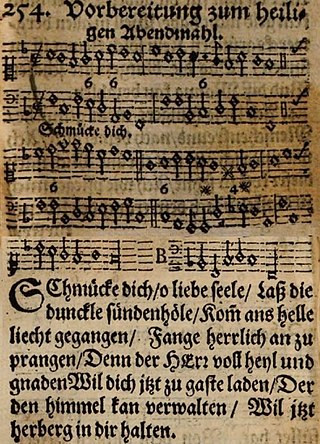
"Schmücke dich, o liebe Seele" is a Lutheran hymn in German, with lyrics by Johann Franck and a hymn tune by Johann Crüger. It was first published in Crüger's 1649 Geistliche Kirchen-Melodien, and was later adopted in other hymnals, such as the 1653 edition of his Praxis pietatis melica.
"Herr Jesu Christ, du höchstes Gut" is the beginning of two Lutheran hymns. One is a penitential hymn, written in 1588 by Bartholomäus Ringwaldt, who possibly also created the melody. The other is an anonymous communion hymn, probably based on the former, which appeared first in 1713. Johann Sebastian Bach's used the penitential hymn several times, including the chorale cantata Herr Jesu Christ, du höchstes Gut, BWV 113, based on the hymn.

"Ach lieben Christen seid getrost" is a Lutheran hymn in German with lyrics by Johannes Gigas, written in 1561. A penitential hymn, it was the basis for Bach's chorale cantata Ach, lieben Christen, seid getrost, BWV 114.
"Aus der Tiefen rufe ich, Herr, zu dir" is a German hymn with a text by Georg Christoph Schwämlein. The opening lines of the hymn stay close to those of Psalm 130, while most stanzas of the hymn are written from a Christian perspective. It was first published, with its own hymn tune, in the Nürnberg hymnal of 1676. Gottfried Vopelius published it with a new hymn tune in the 1682 Neu Leipziger Gesangbuch, p. 936. From 1699 to 1738 the hymn was published with four more new melodies.

